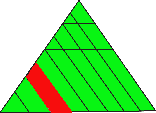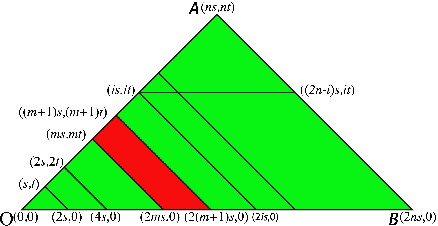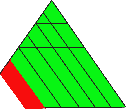Next:
A proof of Theorem Up:
Chocolate games that are
Previous:
Chocolate games that are
1. Introduction
In
this article we study new (bitter) chocolate games. A.C.Robin
introduced a rectangle chocolate game in
[1]
, but it was equivalent to the traditional game of nim.
The
authors have presented new chocolate games whose mathematical
structures were different from that of traditional game of nim in
[5] ,
[6] and
[3] . The
coordinates of the game in [5]
and [4]
satisfy the inequality
 , and the coordinates of the game in
[6] satisfy the
inequality
, and the coordinates of the game in
[6] satisfy the
inequality
 . As to the coordinates
. As to the coordinates
 of chocolate see Definition 1.4
of this article.
of chocolate see Definition 1.4
of this article.
In
 the authors presented many kinds of graphs produced by the set of
L-states of the chocolate games.
the authors presented many kinds of graphs produced by the set of
L-states of the chocolate games.
In Section 1
the authors present new chocolate games, and the coordinates of the
games satisfy the inequality
 . In this section a formula for the set of L states of this chocolate
game is presented.
. In this section a formula for the set of L states of this chocolate
game is presented.
In Section 2
we prove this formula. This formula has been already presented in
[7], but the essential part of the
proof that is presented in this section is more simple and clearer
than that in [7].
In [7]
the authors used Lemma 2.3 (of [7]) to
prove Theorem 2.2 (of [7]), but many
people told authors that this Lemma and this Theorem are difficult to
understand. In this article authors make Lemma 2.4
to prove Theorem 2.2
that is mathematically equivalent to Theorem 2.2 in [7].
By using Lemma 2.4
the proof of Theorem 2.2
becomes quite clear, and this is one of the important points of this
article.
In
Section 3 the authors
presented two predictions for the case of
 . They have not managed to prove these, but they present the result
of the calculation by Mathematica ( a computer algebra system) to
show that these predictions seem to be plausible.
. They have not managed to prove these, but they present the result
of the calculation by Mathematica ( a computer algebra system) to
show that these predictions seem to be plausible.
In Section 4
the authors present some interesting graphs made by the sets of L
states of the chocolate for
 . In this section the authors do not present any theory of
mathematics, but the graphs presented here are very unique and they
cannot be found anywhere else.
. In this section the authors do not present any theory of
mathematics, but the graphs presented here are very unique and they
cannot be found anywhere else.
First,
we define the chocolate games. See the example of chocolates in
Example 1.1.
Definition
1.1 Given a pieces of chocolate, where the light green
parts are sweet and the red part is very bitter. This game is played
by two players in turn. Each player breaks the chocolate (in a
straight line along the grooves) and eats the piece he breaks off.
The player to leave his opponent with the single bitter part is the
winner.
Remark
1.1
Note
that in Definition 1.1 we are not
considering a misere play, since the player who breaks the chocolate
for the last time is the winner, since his opponent cannot break the
remaining red (bitter) polygon. Therefore the chocolate games in this
article are normal play games.
Example
1.1
We
study the chocolate in Fig
 1.1. We call this chocolate as a
1.1. We call this chocolate as a
 chocolate by using the number of rows and columns of the chocolate.
We cut chocolate along the black lines, and the chocolates can be cut
horizontally or vertically. When a player cut the chocolate into two
parts, he eat the part that does not contain the bitter part of the
chocolate. If he cut the chocolate vertically, he leaves the
chocolate by using the number of rows and columns of the chocolate.
We cut chocolate along the black lines, and the chocolates can be cut
horizontally or vertically. When a player cut the chocolate into two
parts, he eat the part that does not contain the bitter part of the
chocolate. If he cut the chocolate vertically, he leaves the

 chocolate. For example if he cut one column, then he leaves the
chocolate of Fig1.2. If he cut the
chocolate horizontally, he leaves the
chocolate. For example if he cut one column, then he leaves the
chocolate of Fig1.2. If he cut the
chocolate horizontally, he leaves the

 chocolate. For example if he cut one row or two rows, then he leaves
the chocolate of Fig1.2 or Fig 1.4
respectively.
chocolate. For example if he cut one row or two rows, then he leaves
the chocolate of Fig1.2 or Fig 1.4
respectively.
If we start with the chocolate in Fig
1.1. , any chocolate that appears in the
game can be expressed as a

 chocolate.
chocolate.

Figure
1.1


Figure
1.2


Figure
1.3


Figure
1.4

Suppose
that we play with the chocolate in
Fig 1.1 , then which
player wins the game the first or the second? In fact the first
player can win the game. The method is quite simple. If
you play as the first player, you have only to move to Fig 1.4.
Then your opponent will go to a
 chocolate or a
chocolate or a
 chocolate. Then you have only to go to a
chocolate. Then you have only to go to a
 or
or
 chocolate. The strategy is go to a square chocolate every time,
and finally you reach the
chocolate. The strategy is go to a square chocolate every time,
and finally you reach the
 chocolate and win the game.
chocolate and win the game.
Definition
1.2 Here we define two important states of chocolates.
 W States, from which we can force a win, as long as we play correctly
at every stage.
W States, from which we can force a win, as long as we play correctly
at every stage.
 L States, from which we will lose however well we play, but we may
end up winning if our opponents make a mistake.
L States, from which we will lose however well we play, but we may
end up winning if our opponents make a mistake.
Remark
1.2 It is important to realize that the outcome of this
game is not pre-determined, but there is nothing that the potential
loser can do if the potential winner plays correctly at ever stage.
However the potential winner cannot afford to make a single mistake,
for if he does, then his opponent can exploit this.
One of
the most important topics of chocolate games is to find all the L
states and the W states of games. We denote by
 the set of non-negative integers.
the set of non-negative integers.
Remark
1.3
For
the L states of the chocolate of Fig 1.1
see the corner in
[1]
.
See also Theorem 7.12 in [2]
(p-138).
Note that in [2]
they
use the term "P-position" instead of "L state" of
this article.
We
define nim-sum that is important for the theory of games.
Definition
1.3 Let
 be non-negative integers, and write them in base
be non-negative integers, and write them in base
 , so
, so
 and
and
 with
with
 .
.
We define the nim-sum
 by
by
|

|
(1.1)
|
where
 .
.
Theorem
1.1 Let
 .Then
.Then
If
 ,
,
 and
and
 ,then
,then
we have
 .
.
This
is a well known result of nim-sum. For a proof see Theorem 7.12 in
[2] (p-139).
Next we study the chocolates in Fig 1.5
that is a new chocolate game that was made by the authors.


Figure
1.5
We
generalize the chocolate games in Fig 1.5,
and define one of the chocolate games that we study in this article.
Definition
1.4 We make a triangle
 on the 2 dimensional plane with two coordinates by connecting three
points
on the 2 dimensional plane with two coordinates by connecting three
points
 ,
, ,
, with segments, where
with segments, where
 and
and
 is a natural number.
is a natural number.
We connect points
 and
and
 with segments for
with segments for
 , and we also connect points
, and we also connect points
 and
and
 with segments for
with segments for
 , where
, where
 . We make a trapezoid with four points
. We make a trapezoid with four points
 ,
,
 ,
,
 ,
, , and color this trapezoid with red. We color all the other parts of
the triangle
, and color this trapezoid with red. We color all the other parts of
the triangle
 with green. All the segments are in black.
with green. All the segments are in black.
green polygons are
sweet chocolate that can be eaten, and the red trapezoid is the
bitter chocolate that cannot be eaten.

Figure
1.6
You
can cut these chocolate along the segments in three ways.
 You cut parallel to the segment
You cut parallel to the segment
 on the left side of the red(bitter) trapezoid.
on the left side of the red(bitter) trapezoid.
 You cut horizontally above the red (bitter) trapezoid.
You cut horizontally above the red (bitter) trapezoid.
 You cut parallel to the segment
You cut parallel to the segment
 on the right side of the red trapezoid.
on the right side of the red trapezoid.
Therefore it is proper to
represent these chocolates with
 , where x,y,z stand for the maximum numbers of times that we can cut
these chocolate in each direction. For example in Fig 1.5
we can cut 2 times at most parallel to the segment
, where x,y,z stand for the maximum numbers of times that we can cut
these chocolate in each direction. For example in Fig 1.5
we can cut 2 times at most parallel to the segment
 on the left side of the red trapezoid, 2 times at most horizontally
and 5 times at most parallel to the segment
on the left side of the red trapezoid, 2 times at most horizontally
and 5 times at most parallel to the segment
 on the right side of the red trapezoid. Therefore
on the right side of the red trapezoid. Therefore
 ,
,
 and
and
 . Therefore we represent the chocolate in Fig 1.5
with the coordinates
. Therefore we represent the chocolate in Fig 1.5
with the coordinates
 .
.
For any
 we denote by
we denote by
 the state of coordinates.
the state of coordinates.
Example
1.2
Here
we have four examples of states of chocolates that appear when we
play the chocolate game of Fig 1.5


Figure
1.7


Figure
1.8


Figure
1.9


Figure
1.10
It
is clear that the coordinates of these states satisfy the inequality
 , and this is equivalent to the inequality
, and this is equivalent to the inequality
|

|
(1.2)
|
where
 is the floor function. Note that
is the floor function. Note that
 is the largest integer not greater than
is the largest integer not greater than
 for any real number
for any real number
 . Inequality (1.2) is important to understand
the structure of the chocolate. If you start with the chocolate in
Fig 1.5 and reduce the third coordinate
. Inequality (1.2) is important to understand
the structure of the chocolate. If you start with the chocolate in
Fig 1.5 and reduce the third coordinate
 to
to
 by cutting from the upper left to the lower right on the right side
of the bitter polygon, then by the structure of the chocolate the
second coordinate is reduced to
by cutting from the upper left to the lower right on the right side
of the bitter polygon, then by the structure of the chocolate the
second coordinate is reduced to
 .
.
In this way we get the chocolate in Fig 1.7.
If we are to explain the move from the chocolate in Fig 1.5
to the chocolate in Fig 1.7 using Inequality
(1.2), we use the following explanation.
Let
 , then by Inequality (1.2) we get
, then by Inequality (1.2) we get
 .
.
Definition
1.5 Let
 and
and
 ,
,
 and
and
 .
.
Theorem
1.2
Let
 and
and
 be the sets defined in Definition 1.5.
be the sets defined in Definition 1.5.
 is the set of L states and
is the set of L states and
 is the set of W states of the game of Definition 1.4.
is the set of W states of the game of Definition 1.4.
By
Theorem 1.2 we tell L states from W
states, and in Example 1.3 we learn
how to win the game using the theorem.
We
prove this theorem in Section 2.
First, we learn how to use the theorem.
Example
1.3
Here
we use Theorem 1.2, then the chocolate
in Fig 1.5 with the coordinates
 is a W state, since
is a W state, since
 . Therefore you can win if you play as the first player. The strategy
is to move to an L state every time. For example you can move to
. Therefore you can win if you play as the first player. The strategy
is to move to an L state every time. For example you can move to
 that is an L state, since
that is an L state, since
 .
.
In this way you should leave the opponent with an L state every
time until you leave the opponent with the single block of bitter
chocolate whose coordinates are
 . Then the game is finished, and you win the game.
. Then the game is finished, and you win the game.
By
Example 1.3 the strategy to win is
clear. Even if you do not read the proof of Theorem 1.2,
you can be a good player of this chocolate game.
Next:
A proof of Theorem Up:
Chocolate
games that are Previous:
Chocolate
games that are




 and
and
 with
with






